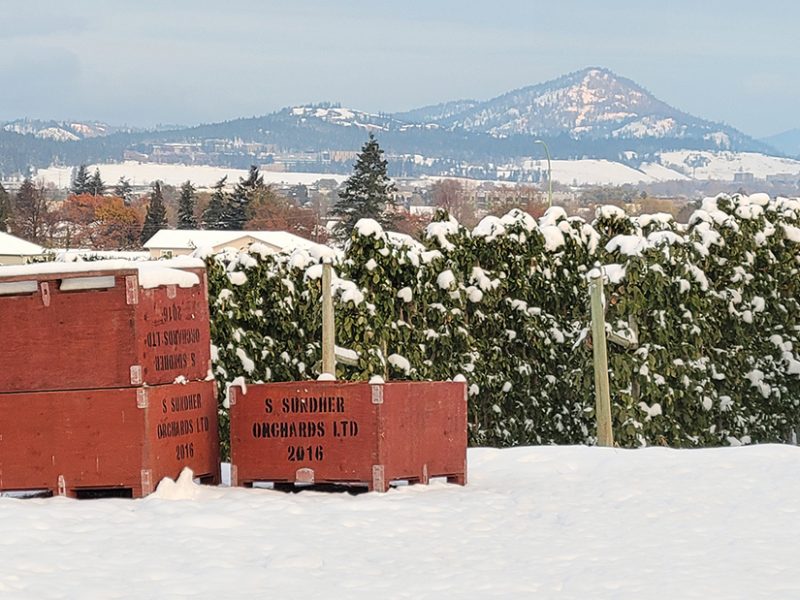CHILLIWACK – The Bank of Canada’s attempts to curb inflation with aggressive interest rate hikes has raised the potential for an economic downturn next year.
On November 4, the federal government published its fall economic statement, which pointed to several risks to the economic outlook. In the report’s “downside scenario,” Canada would enter a “mild recession” in the first quarter of 2023 and the real gross domestic product for the year would drop 0.9%.
“It would be good to have a government that actually had a plan to get out of the recession and we do not have a government that is in any way coming up with a plan,” says Chilliwack chicken grower Dennis Flokstra, Lower Mainland director with the BC Chicken Marketing Board.
He plans to sharpen his pencil even further next year to try to pay off as much debt as possible and cut costs, no small feat this winter given the high cost of energy needed to heat his barns.
“We run a pretty tight ship; I’m not even sure where we would give a little bit,” he says. “We still have to supply heat to the birds, and we still have to treat them as good as we can.”
The higher costs eventually get passed on to consumers, which will be affected “big time” as producers’ costs get passed along. He hopes the province will move ahead with changes to how it collects the carbon tax from growers, giving them a break up front rather than requiring them to apply for a rebate.
While Flokstra is wary of the impact interest rates may have on the industry, he’s confident farmers can ride out a potential recession.
Indeed, the outlook is positive for agriculture’s ability to handle and recover from an economic slowdown.
“Our expectation is that most farm families would weather a recessionary environment, perhaps better than some industries or people working in consumer goods or other retail-based business that are less immune to recessionary pressures,” says Royal Bank of Canada’s national director of agriculture Ryan Riese.
“The demand for farmers’ products may change, to some degree. But we are working largely with fairly inelastic products where consumers do need to eat.’
But a recession isn’t a sure thing. Farm Credit Canada vice-president and chief economist JP Gervais notes that a recession is typically defined as two consecutive quarters of negative growth in GDP.
Canada could simply see zero economic growth in back-to-back quarters, for example, not negative growth. This means the situation wouldn’t be labeled a recession.
“I don’t think it’s an automatic outcome or an assured outcome that we will get a recession,” Gervais says.
If there is a recession, Gervais says “a very, very strong labour market” means consumer spending may be a minor consideration.
While higher interest rates are expected to slow down consumer purchases, wages increased 5.4% over the last year and Gervais says that could help offset the impacts of a slowing economy.
For producers, the impact of an economic downturn will depend on whether the recession happens solely in the Canadian economy or is widespread in the global economy.
“If it was just a recession in Canada, I don’t think the impacts would be significant for farmers,” Gervais says. But a global economic recession could mean lower profitability for producers who buy and sell commodities on the global market.
“If we look at most of the commodities grown on Canadian farms, a lot of those commodities are tied to some extent, and in a lot of cases, to a really large extent, to world demand,” Gervais says.
Poultry and dairy are influenced by domestic factors because of supply management, but beef, pork, grains and oilseeds, and fruits and vegetables are all tied to the global market.
“So, if the world economy slows, demand for these commodities is going to weaken. Weaker demand means lower prices,” Gervais says.
In addition to an uncertain economic climate, producers continue to face unpredictability in terms of fertilizer price and availability due to the war in Ukraine.
Wages will continue to climb, too, Gervais predicts. BC’s minimum wage increased to $15.65 per hour on June 1, and the province’s average annual inflation rate will guide any increase announced in 2023.
To help weather the storm of uncertainty, producers should have business risk management plans.
These plans consider how interest rates, inflation and commodity and input prices, for example, impact bottom line and financial risk, Gervais says.
But producers do not need to navigate these waters alone.
“Anytime something like this happens, it’s a good reminder to put the pen to paper and sit down with those other people who are integral to your operation and map out where you want to go with your future,” says Riese.


 AI outbreak rivals 2004
AI outbreak rivals 2004